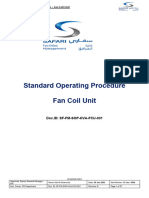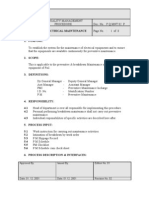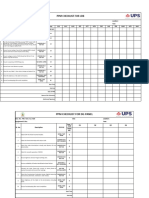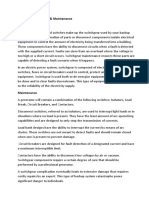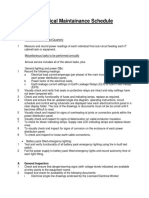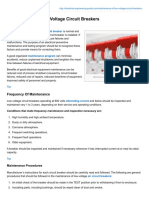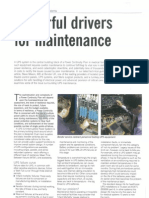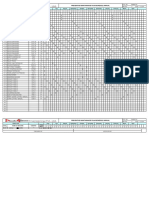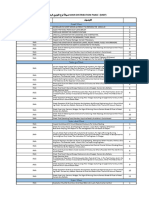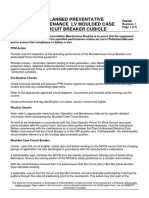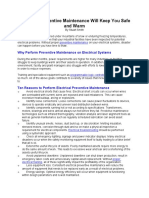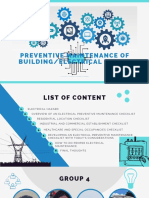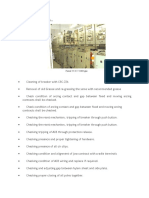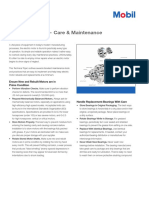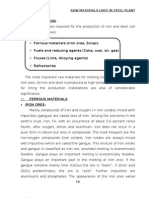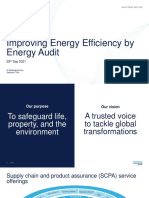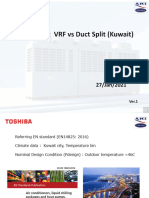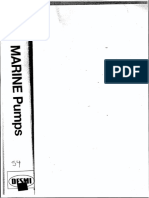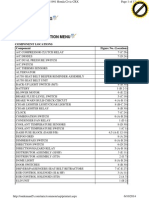Power Engineering
Pages
Home
Saturday, 13 October 2012
Preventive Maintenance and checklist
HV END CONNECTOR
Preventive maintenance checklist
Why Perform Preventive Maintenance on Electrical Systems
During the winter and summer months, power requirements are higher for many
industries as facilities struggle to keep buildings warm and their assets in operation.
In addition, in today's economic environment, facility and plant managers also
struggle with efforts to lower power consumption in order to reduce expenses.
Reasons to Perform Electrical Preventive Maintenance
THERE IS SAYING A STITCH IN TIME SAVES NINE.
1.
Avoid electrical shorts that cause fires: Electrical short circuits can occur
when wires are overloaded with current, wires are exposed and load imbalances.
This can cause excessive heat build-up, arcing or explosions.
�2.
Identify loose connections: Loose connections can cause power fluctuations to
devices, devices to operate erratically and uneven load distribution between wires.
3.
Identify components running hot or not according to specifications:
Transformers, motors, bearings and wires almost always run hot before they fail.
Predictive maintenance technologies such as infrared Thermography, vibration
analysis and laser alignment tools as well as general maintenance such as regularly
scheduled lubrication can avoid asset failure.
4.
Identify unusual smells, noises, dust build up, or discoloration: Melting
insulation, stressed motors, corrosion through dust and so on make a physical
inspection a requirement for electrical components. Electrical troubleshooting and
simulation should be performed using a systematic approach.
5.
Check all emergency lighting, signage and power indicator displays: Many
electrical disasters occur when the safety monitoring equipment itself is faulty
leading to a false belief that all is ok.
6.
Extend the useful lifecycle of assets: Poorly maintained assets require more
energy to do the same amount of work. This leads to excessive wear and tear and a
shortening of the assets useful lifecycle.
7.
Avoid unplanned downtime: Unplanned downtime can shut down production,
result in emergency labour costs and unnecessary capital asset replacement.
Without proper electrical training, all of these significantly impact the profitability of
the organization.
8.
Less equipment loss: Consistent electrical preventive maintenance will reduce
the amount of equipment that needs to be replaced early as a result of electrical
problems.
9.
Energy savings: Optimal energy efficiency will occur when equipment is
functioning within design parameters and is well maintained.
10. Safety and Liability: The most important reason of all is safety. Avoiding
serious injuries or death is worth every penny spent on prevention. Liability lawyers
have a field day when facilities have a poor maintenance record.
How Often Should Electrical PM be done?
�TRANSFORMER LV BUSHING
Electrical systems should have a thorough inspection by a qualified electrician. The
frequency quarterly, half yearly, annually, bi-yearly so on. It depends on the
service of the equipments and decision should be taken by section head. Individual
assets should be inspected according to manufacturer directions or based upon
experience and industrial training in a particular environment. For example, some
motors may need to be inspected quarterly, air handlers annually and so on.
Preventive maintenance, inspections and work orders are best handled using your
own excel sheet or specialised software for the scheduling and recording of activity,
results and notes.
Preventive maintenance of electrical systems goes beyond the visual or scheduled
predictive maintenance work. A full electrical PM is a complete look at the electrical
system including;
Sample Electrical PM Items
o
Compliance to safety audit recommendation
Re-torque connections
Checking panel boards
Inspecting control logic/scheme/PLCs for effectiveness
Examining work orders as well as new installs for compliance and uniformity
Making sure lock-out tags are in place
Inspection of heating and cooling units
Lighting
Shutdown mechanisms
NEC code compliance
Electrical inspection checklists and resources
Every organization has a unique set of assets. Therefore, it is unlikely that the same
electrical inspection checklist will be the same. Generally manufacturer provides the
checklist for maintenance it should be adhere to or with own practice we can
develop ourselves.
GENERAL ANNUAL CHECKS
(1) Review past maintenance records to find repair patterns. These records may
point to certain components that should be closely inspected during performance of
preventive maintenance.
(2) Review operator records concerning electrical load readings; compare with
equipment ratings. Operator records regarding operating temperatures and any
documented abnormal circumstances associated with the system should also be
reviewed.
(3) Inspect Secondary Electrical Distribution Equipment:
(a) Inspect to ensure that warning signs exist. Replace as required.
(b) Inspect enclosures for damage, unauthorized openings, and corrosion of
metallic objects. Repair and paint as required.
(c) Inspect air passages and remove any blockage.
(d) Inspect, investigate, and solve conditions for unusual odors.
(e) As equipment is operated and tested, listen, investigate, and solve conditions
for unusual noises.
(f) Inspect electrical connections for degradation and tightness. Repair as required.
(g) Inspect electrical insulation for discoloration and degradation. Repair as
required.
(h) Inspect equipment grounding components such as conductors and connections.
Repair as required.
(i) Inspect insulators for damage. Replace as required.
(j) Inspect liquid immersed equipment for leaks and damage.
(k) Inspect indicating lights for correct illumination.
(4) Remove debris, dirt, and other foreign objects from all components, housings,
cabinets, panels, etc.
(5) Torque all electrical connections to design value..
(6) Verify operation of space heaters and control thermostat. Check thermostat set
�point for proper setting.
(7) Verify the grounding of the equipment and associated neutral where applicable.
(8) Conduct infrared test on all main current carrying equipment for hot spots that
may indicate overload conditions or loose connections.
(9) Using calibrated test instruments, calibrate ammeters, voltmeters, etc. Verify
continuity of metering selector switch contacts with ohmmeter.
Sample
Check List for Transformer Maintenance
Date:
Substation No:
Transformer No:
Sl
no
Activities
Obtain LC from Sub-station Operation
Check for oil leakages
Check for oil level in the conservator tank
is up to 3/4th mark
Check for Breather condition
Check for Silica Gel condition
Clean the body
Open the terminal box check the following
a)
Tightness of terminal connection
b)
Condition of bushings
c)
Any sign of overheating.
Check for any unplugged opening, missing
bolts
Check all terminal box tightness
10
Check oil/winding temperature setting
11
Check earthing system is proper & intact
12
Check cable support
Voltage Ratio:
Checks
carried
Remarks
�13
14
Check IR value
a) Primary
: P-E
b) Secondary
: P-E
Any other abnormality
Signature
Check List for Switch Board Maintenance
Date:
Substation No:
SWB No:
Rating:
Sl
no
Activities
Obtain LC from Sub-station Operation
Ensure isolation of the Incomer and Bus coupler
breaker and control supply and Heater supply of the
section
Ensure all back feeding sources are isolated
Remove all breakers/modules and PT Cubicles (If it is
draw able type)
Open the top and side covers of the busbar chamber.
Clean the busbar chamber, breaker rear and front
compartment with air blower, vacuum cleaner and dry
cloth.
Clean all insulators by soft dry cloth & contact Cleaner.
Check for cracks, damages & replace the defective
Checks
carried
Remarks
�one.
8
Check and tighten the exposed joints of the busbar.
Check for any signs of heating.
Check and tighten the power connections of CT/ PT
and out going cables.
10
Check for any unplugged opening, missing bolts
11
Box up busbar chamber & rear compartments of
breaker.
12
Check earthing system is proper & intact
13
Check IR value
a) R-E
14
b) Y-E
c) B-E
Any other abnormality
Signature
Posted by Bhagawan Prasad at 18:52
Email ThisBlogThis!Share to TwitterShare to FacebookShare to Pinterest
3 comments:
Andrei Morris12 February 2013 at 18:57
When your business depends on electrical machinery and equipment for increased
productivity and improved cash flow, it is extremely important to keep that
machinery inspected and well-maintained on a regular basis. Preventive electrical
equipment maintenance done regularly by trained, professional and experienced
electrical workers helps to detect electrical problems before they become serious
issues. By scheduling routine maintenance checks that utilize advanced technology
�and expert electrical skills, the industrial equipment and machinery on which your
business runs can continue working efficiently, reducing the risk of a catastrophic
failure that can cost time and money. Read on to learn the benefits of preventive
electrical equipment maintenance, as well as the use of infrared thermography in
detecting electrical problems.
Save Time and Money:
An effective preventive electrical maintenance program involves scheduling routine
inspections and checkups on a regular basis, ensuring that your equipment and
machinery is continually checked for both minor and major problems. Even small
electrical problems can become more severe issues if left undetected for too long,
which can lead to emergency repairs that require halted production lines and costly
replacement parts. In a challenging global economy that demands cost-effective
mass production on a timely basis, stopping production due to equipment failure
can have major setbacks.
A Safer Workplace:
Not only can preventive electrical maintenance save businesses time and money,
but by keeping equipment functioning properly, the risk of hazard is greatly reduced
and the work environment becomes a safer place. Electrical equipment failure can
lead to serious hazards, including fires and arc flash, which can leave workers
severely injured. Equipment that is not working properly or problems that are left
undetected can have unfortunate results for electricians working with or near the
equipment. Machinery should be inspected frequently to identify potential problems
and prevent them from becoming dangers in the workplace.
Using Infrared Thermography:
The use of infrared (IR) thermography is critical to preventive maintenance in
electrical work environments. All objects radiate thermal energy, or heat, and IR
cameras can detect the radiation of heat that is emitted from any given object by
taking "heat" images. Through a range of colors, these images present hot spots
that cannot otherwise be perceived by the naked eye. IR thermography is used to
reveal loose circuits, equipment failure and safety hazards. Electrical workers can
then use the thermographic images to analyze and measure temperatures,
identifying problems and fixing them before they become severe.
Mark from Electrical Maintenance
ReplyDelete
Bhagawan Prasad7 March 2013 at 06:50
thanks for nice comments
ReplyDelete
�kimwhite37413 November 2013 at 07:43
Thank you for sharing. Predictive Maintenance (PdM) Technology Applications and
Services should be part of an overall equipment maintenance program to build
lasting return on investment and impact on asset health.
ReplyDelete
Add comment
Load more...
Newer Post Older Post Home
Subscribe to: Post Comments (Atom)
Followers
Blog Archive
2015 (30)
September (2)
July (2)
June (6)
May (19)
April (1)
2014 (5)
November (1)
September (2)
August (1)
July (1)
2013 (21)
November (2)
October (4)
September (2)
August (1)
July (4)
� June (3)
May (4)
April (1)
2012 (55)
December (2)
November (4)
October (5)
Panel Space Heater
Electrical Circuit for cracker firing
Preventive Maintenance and checklist
Can Earth wire be avoided on O/H Lines?
Electrical Testing and Commissioning Of Switch Boa...
September (7)
August (7)
July (1)
June (1)
May (6)
April (19)
February (2)
January (1)
About Me
Bhagawan Prasad
Panipat, Haryana, India
Electrical Engineer having 20 years experience in Power Distribution, Electrical
Maintenance, Electrical Projects, basic of SAP, Design, estimation and costing of
power distribution,EPC for indoor substation,street lighting, Language with English,
�Hindi, Bhojpuri Keen interested in Sharing information/experience and help technical
enthusiasts to update themselves on various Engineering
Topics.CONTACT:amieclub@gmail.com
View my complete profile
Picture Window template. Powered by Blogger.













